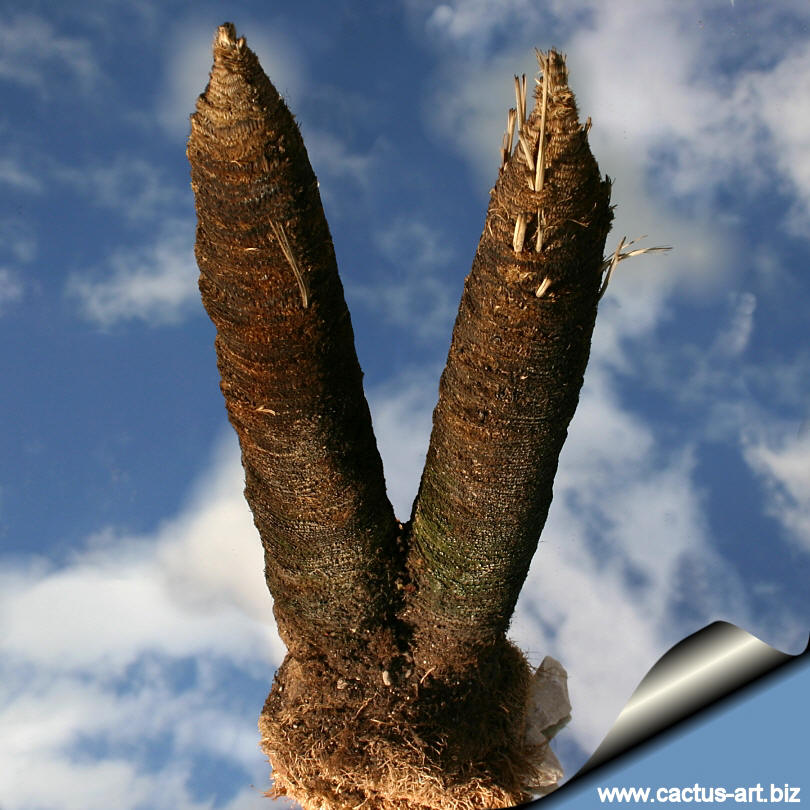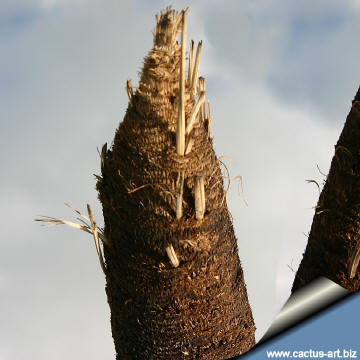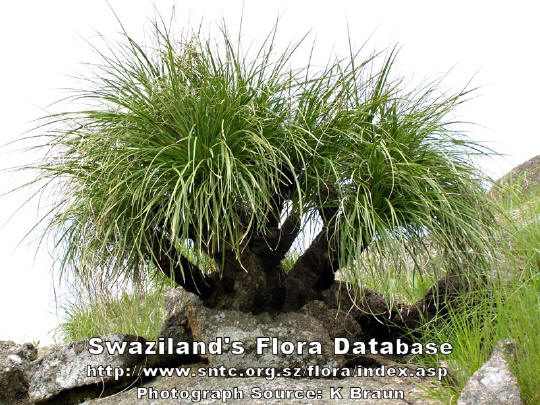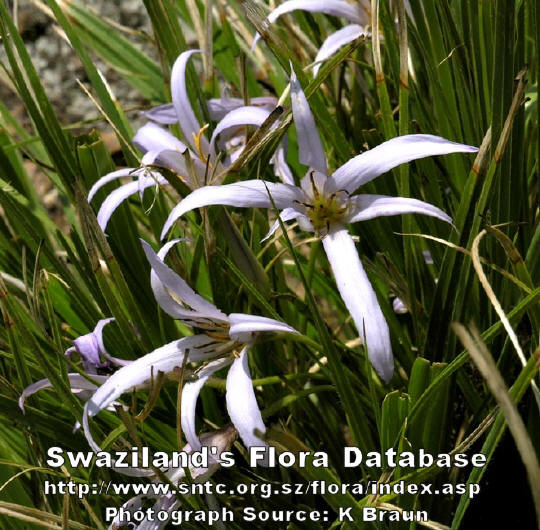|
|
|

Xerophyta retinervis (Monkey tail)
This is an unusual (and
very tough) plant.
In winter it resemble
knee-high dead stumps. It can
survive long periods without water, and then, when the rains come,
"resurrect itself", it is
virtually unknown in cultivation. |
|
Description: Perennial
shrub, usually about 0,6 m tall, tipped with elongated strap shaped
leaves, but can grow up to 1,8m high in favourable conditions.
Stem: Dark, upright, grey to black tufted, very robust, solitary or
(usually) irregularly branched; its dark stumpy appearance
is a conspicuous
feature.
Roots: Fibrous.
Leaves: Long light green, narrow,
lanceolate in clusters spread
over the dark stem.
Flowers: The deep mauve or pale blue flowers are borne on long
thin stalks, they are sweetly scented large and very attractive.
Perianth segments usually more than 4 cm long.
Blooming seson: Plants tend to flower irregularly at the
beginning of the summer season, just as the new rains start.
Fruit: The fruits are
capsules the seed is set quickly and ripens
in about 6 weeks.
|
|

 |
 |
|
 |
|
What is so unique about
Xerophyta among the higher plants, is that it is able to survive long
periods without water with extremes of temperature and high winds. When
it rains again, the plants rehydrate completely and remarkably resume
their full metabolic functions within 24 to72 hours. And also it
survives fires through a protective coat of fibrous leaf bases which
persist on the stem. |
|
Dehydration: One of the major consequences of
drought stress is the loss of water from the plant cells. This leads
to the concentration of ions in the cell
protoplasm. Many of these ions are toxic to plants at high
concentrations. In this condition, whatever
liquid is left in the cell has a high viscosity, increasing the chances
of molecular interactions that can cause proteins to denature,
and membranes to fuse . This causes problems for the plant,
because if a broad band of proteins have been denatured, they can't
continue with their normal metabolic cycles. All
plants display some ability to tolerate environmental stress to varying
degrees. However, the resurrection plants like
Xerophyta, take this a step further. This is not entirely unusual.
An array of metabolic pathways have been found to be activated under
conditions of water deficit in other plants. What is important is that
Xerophyta uses its metabolic strategies more efficiently and that
allow the plant to tolerate extreme environments.
Propagation: Usually propagated by seed, sow the seed on a
seedling mix that is able to hold water, as you would for cacti. (E.g.
cover the seed tray with a plastic baggie and set it in bright shade )
They sprout quickly. But keep the water level in the container high.
Watering the seedlings (Preferably) from below, or leaving the tray
sitting in a bath of water. Seed germinates in about 2–4 weeks. Leave
the seedlings in the trays for a season to get root-bound. Divide them
just before the second growing season starts. The seedling grows fairly
slowly (only a few mm per year) but when acclimatized they can grow
faster.
|
|


Advertising
|
|
|
|
|
Family: Velloziacee |
|
Scientific name: Xerophyta
clavata Baker
Origin: Eastern South Africa (widespread, but not abundant
in Limpopo, Gauteng and Mpumalanga provinces and in Swaziland)
Habitat: Occupies a very specialized
ecological
niche in seasonally high rainfall regions, growing in in
grasslands on rocky outcrops and cliffs with shallow soil. On such
rocks, weathering leads to cracks and ridges where organic matter like
leaves, and dust, fill in the irregularities, forming mats about a centimeter thick. Mosses form on these mats, and various plants sprout
in these organic mats, sending their roots quite some distance
horizontally, but never more than a centimeter or two deep. The mats
enlarge over time. In the summer rainy season, the mats are probably
always moist to wet. Once the leaves of the X. retinervis are
air-dry, they can remain viable for prolonged periods. The dry 'winter'
season lasts 5 to 6 months.
Common Names include: Monkeys Tail, Baboon tail,
Resurrection plant, black stick lily, wonder bush
|
Synonyms:
-
Vellozia retinervis Baker
In: W. T. Thiselton-Dyer, Fl. cap. 6:244. 1896
-
Barbacenia retinervis (Baker) Pax ex
Burtt Davy
-
Vellozia clavata (Baker) Baker
-
Hypoxis vellosioides Harv
|
|
The photos below show this
plant in habitat.
(Source & copyright
Swaziland's Flora Database )
Photograph Source: K Bran

http://www.sntc.org.sz/flora/photo.asp?phid=1175
Xerophyta retinervis is a
most interesting plant. It relies on wild fires to trigger into life.
Usually it is just a dry black stick in the ground.
http://www.sntc.org.sz/flora/photo.asp?phid=2011
In
spring it is transformed and is crowned with bouquets of lilac,
lily-like blooms.

http://www.sntc.org.sz/flora/photo.asp?phid=1162
Photograph Source: K Braun
This peculiar plant somewhat resembles a
miniature yucca or palm tree.
|
|
|
|

http://www.sntc.org.sz/flora/photo.asp?phid=2010
Photograph Source: K Braun
Cultivation: General succulent culture is needed. The water
available heavily influences their growth. Plants have developed
astonishing strategies to survive lengthy periods of drought unharmed,
they dry out, and in a desiccated state can
withstand drought, often for months. When watered, even after a long
period of drought, the plants can quickly regain an active state. With
several plants of this kind, the dried-out leaves
turn green after just a few hours.
Xerophyta retinervis can grow in the same pot for many years, never
needing to re-pot it. It is very cold hardy to at least -12° C.
USE: This plant has many medicinal applications, it is known in Zulu
as 'isiphemba' or 'isiqumama' The roots are smoked to relieve asthma and
smoke from the whole plant is used to stop nosebleeds. Stem bark
preparations are reported to have anti-inflammatory and analgesic
properties. The active ingredient, called amentoflavone, is also found
in gingko extract.
|
|